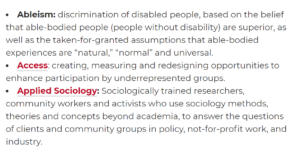Study bites: DIY Glossary
02 Sep 2021
Create your own glossary
Do you ever find yourself having to go back to the textbook or key texts to check up on the specific meaning of a term or concept? Are there some ideas that you haven’t been able to fully grasp even though you have come up against them again and again? If so, you would benefit from writing up your own glossary for your personal reference.
What is a glossary?
In academia, a glossary is a list of terminology and concepts that are discipline specific. Rather than dictionary definitions, which can be multiple and include general understandings, glossaries clearly define terms in their particular context and may include relevant examples.
Below is an example from sociology:

As distinct from a glossary for a book or publication, your glossary could focus solely on the terms that you struggle to recall in context, or that are key to your course or discipline.
Why do I need one?
Creating your own glossary of key words and concepts from your course or discipline is a great way to strengthen your understanding of the course content, practice paraphrasing ideas, and to help organise your workload in a way that is manageable and easily accessible. You can refer to your glossary for assessments or exams and can even share it with your peers, to check for understandings and identify when we may need to be more explicit or more specific.
How do I make one?
There are plenty of technological tools for generating your own interactive, online glossaries but these are not necessary. Since this is primarily for the purposes of your own understanding, I suggest keeping it simple. Just ensure you are careful not to plagiarise when you are paraphrasing by referencing where necessary. This will also be useful so that you can return to the source if you have any doubts or want to follow up on them.
Here is a suggestion for how to begin:
- Identify the key terms and concepts that you have come across in your coursework.
- Write these terms and concepts out in alphabetical order in a Word document.
- Consult multiple sources for the definition and application of your terminology in your disciplinary area, beginning with textbooks and required readings from your course. Notice any discrepancies between them. Paraphrase the main ideas where there is consensus and note any differences in interpretation. Reference these differences where necessary and refer to the different philosophies or schools of thought that they relate to.
- Once you have a list of terms in alphabetical order (especially if you have an extensive list), you can put these into a table of contents. A simple way to do this is to assign each of your terms a “Style” (see top tab).
- Choose Heading 1 for your terms. Leave a space and write your definitions.
- Place the cursor at the top of the page and then, go to “References” in the top tab and choose Table of Contents. Select an automatic table (see below). A table of contents should be automatically generated.

- You can then hold CNTRL and right click on each term and it will take you to that term in your document. Simple as that!
Give it a go and then share it with your peers to check for understanding and learn from one another! You may even like to collaborate in the writing process! Once you have a fab glossary, you can refer to it for assessments and exams as needed and build on it as you find new terms along the way!
If you’d like some assistance on setting up your own glossary, book in a Learning Skills Session with Ella,

0 Comments
There are currently no comments, be the first to leave one